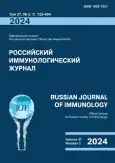Генетическая модификация первичных В-клеток человека для моделирования процессов в зародышевых центрах
- Авторы: Бязрова М.Г.1,2, Сухова М.М.1,3, Михайлов А.А.1,3, Прилипов А.Г.1, Филатов А.В.1,3
-
Учреждения:
- ФГБУН «Государственный научный центр “Институт иммунологии”» ФМБА
- ФГАОУ ВО «Российский университет дружбы народов имени Патриса Лумумбы»
- ФГБОУ ВО «Московский государственный университет имени М.В. Ломоносова»
- Выпуск: Том 27, № 2 (2024)
- Страницы: 133-138
- Раздел: КРАТКИЕ СООБЩЕНИЯ
- URL: https://journals.rcsi.science/1028-7221/article/view/263653
- DOI: https://doi.org/10.46235/1028-7221-16622-GMO
- ID: 263653
Цитировать
Полный текст
Аннотация
Основные этапы созревания антиген-специфических В-клеток протекают в герминативных центрах лимфоузлов. Здесь наивные В-клетки проходят процесс соматического гипермутагенеза, а также переключение классов синтезируемых антител. В процессе дифференцировки принимается решение, по какому пути В-клетки будут развиваться далее. Они либо превратятся в короткоживущие плазмабласты, либо в В-клетки памяти или плазматические клетки. Взаимоотношение этих процессов очень важно для развития продуктивного гуморального иммунного ответа. Имеется насущная необходимость в более детальном изучении отмеченных процессов. Целью работы являлось создание системы, которая ex vivo способна моделировать процессы, протекающие в герминативных центрах. В качестве исходного материала мы использовали первичные В-клетки из периферической крови человека. После иммуномагнитной сепарации В-лимфоциты стимулировали in vitro с помощью фидерных клеток, несущих молекулы CD40L. Другим стимулирующим фактором являлся рекомбинантный растворимый IL-21. При IL-21/CD40L стимуляции В-лимфоциты изменяли свою морфологию, поверхностный фенотип, а также функциональную активность. После активной экспансии в течении 10 дней дальнейший рост клеток останавливался, и через некоторое время они погибали. Для получения стабильно пролиферирующих В-клеток мы использовали лентивирусную трансдукцию IL-21/CD40L стимулированных IgM+ В-лимфоцитов. Для этого были получены препараты лентивируса, которые несли кассету, состоявшую из генов BCL6 и BCL2L1, разделенных последовательностью кодирующей саморазрезаемый пептид P2A, а также репортерный ген GFP, отделенный от целевых генов элементом IRES. Использованная кассета обеспечивала в клетках-мишенях синтез транскрипционного фактора Bcl-6 и белка Bcl-XL. Репрессор Bcl-6 не позволял В-клеткам уходить в терминальную дифференцировку и превращаться в плазматические клетки, а белок Bcl-XL оказывал анти-апоптотическое действие. Трансдуцированные В-клетки пролиферировали более месяца и сохраняли фенотип плазмабластов. При этом через 42 дня после начала стимуляции трансдуцированные В-клетки оставались GFP-позитивными, коэкспрессировали антигены CD27 и CD38, несли поверхностный CD20 и IgM, внутриклеточный Bcl-6, Bcl-XL и IgM, сохраняли секрецию IgM, но оставались негативными по поверхностному и внутриклеточному IgG. Таким образом, длительное культивирование В-клеток не приводило к переключение класса синтезируемого Ig. Отработанная система стимуляции позволит имитировать ключевые аспекты развития В-клеток в зародышевых центрах для изучения формирования В-клеточной памяти, что в конечном счете будет способствовать разработке эффективных вакцин.
Ключевые слова
Полный текст
Открыть статью на сайте журналаОб авторах
М. Г. Бязрова
ФГБУН «Государственный научный центр “Институт иммунологии”» ФМБА; ФГАОУ ВО «Российский университет дружбы народов имени Патриса Лумумбы»
Email: avfilat@yandex.ru
научный сотрудник лаборатории иммунохимии; ассистент кафедры иммунологии медицинского института
Россия, Москва; МоскваМ. М. Сухова
ФГБУН «Государственный научный центр “Институт иммунологии”» ФМБА; ФГБОУ ВО «Московский государственный университет имени М.В. Ломоносова»
Email: avfilat@yandex.ru
младший научный сотрудник лаборатории иммунохимии; аспирант кафедры иммунологии биологического факультета
Россия, Москва; МоскваА. А. Михайлов
ФГБУН «Государственный научный центр “Институт иммунологии”» ФМБА; ФГБОУ ВО «Московский государственный университет имени М.В. Ломоносова»
Email: avfilat@yandex.ru
лаборант лаборатории иммунохимии; студент кафедры иммунологии биологического факультета
Россия, Москва; МоскваА. Г. Прилипов
ФГБУН «Государственный научный центр “Институт иммунологии”» ФМБА
Email: avfilat@yandex.ru
д.б.н., старший научный сотрудник лаборатории иммунохимии
Россия, МоскваА. В. Филатов
ФГБУН «Государственный научный центр “Институт иммунологии”» ФМБА; ФГБОУ ВО «Московский государственный университет имени М.В. Ломоносова»
Автор, ответственный за переписку.
Email: avfilat@yandex.ru
д.б.н., профессор, заведующий лабораторией иммунохимии; профессор кафедры иммунологии биологического факультета
Россия, Москва; МоскваСписок литературы
- Бязрова М.Г., Астахова Е.А., Спиридонова А.Б., Васильева Ю.В., Прилипов А.Г., Филатов А.В. Стимуляция В-лимфоцитов человека in vitro с помощью ИЛ-21/CD40L и их характеристика. Иммунология, 2020. Т. 41, №. 1. С. 18-27. [Byazrova M.G., Astakhova E.A., Spiridonova A.B., Vasileva Yu.V., Prilipov A.G., Filatov A.V. IL-21/CD40L stimulation of human B-lymphocytes in vitro and their characteristics. Immunologiya = Immunologiya, 2020, Vol. 41, no. 6, pp. 18-27. (In Russ.)]
- Boswell K.L., Watkins T.A., Cale E.M., Samsel J., Andrews S.F., Ambrozak D.R., Driscoll J.I., Messina M.A., Narpala S., Hopp C.S., Cagigi A., Casazza J.P., Yamamoto T., Zhou T., Schief W.R., Crompton P.D., Ledgerwood J.E., Connors M., Gama L., Kwong P.D., McDermott A., Mascola J.R., Koup R.A. Application of B cell immortalization for the isolation of antibodies and B cell clones from vaccine and infection settings. Front. Immunol., 2022, Vol. 13, 1087018. doi: 10.3389/fimmu.2022.1087018.
- Diehl S.A., Schmidlin H., Nagasawa M., van Haren S.D., Kwakkenbos M.J., Yasuda E., Beaumont T., Scheeren F.A., Spits H. STAT3-mediated up-regulation of BLIMP1 is coordinated with BCL6 down-regulation to control human plasma cell differentiation. J. Immunol., 2008, Vol. 180, no. 7, pp. 4805-4815.
- Ding B.B., Bi E., Chen H., Yu J.J., Ye B.H. IL-21 and CD40L synergistically promote plasma cell differentiation through upregulation of Blimp-1 in human B cells. J. Immunol., 2013, Vol. 190, no. 4, pp. 1827-1836.
- Inoue T., Kurosaki T. Memory B cells. Nat. Rev. Immunol., 2024, Vol. 24, no. 1, pp. 5-17.
- Inoue T., Shinnakasu R., Kurosaki T. Generation of high-quality memory B cells. Front Immunol., 2022, 12, 825813. doi: 10.3389/fimmu.2021.825813.
- Kwakkenbos M.J., Diehl S.A., Yasuda E., Bakker A.Q., van Geelen C.M., Lukens M.V., van Bleek G.M., Widjojoatmodjo M.N., Bogers W.M., Mei H., Radbruch A., Scheeren F.A., Spits H., Beaumont T. Generation of stable monoclonal antibody-producing B cell receptor-positive human memory B cells by genetic programming. Nat. Med., 2010, Vol. 16, no. 1, pp. 123-128.
- Kwakkenbos M.J., van Helden P.M., Beaumont T., Spits H. Stable long-term cultures of self-renewing B cells and their applications. Immunol. Rev., 2016, Vol. 270, no. 1, pp. 65-77.
Дополнительные файлы










